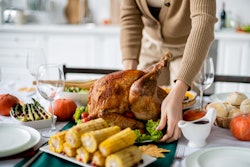
The turkey industry took more than its fair share of lumps in the past decade, but things may be pointing up in 2023.
In a WATT Poultry Chat interview, Mark Jordan, executive director of LEAP Market Analytics, examined the strange scenario created by the recent highly pathogenic avian influenza crisis as well as the longer term trend of declining per person turkey consumption in the U.S.
Austin Alonzo: The turkey industry is in a prolonged slump, with 2022 marking five consecutive years of declining production. Will turkey do any better in 2023?
Mark Jordan: I would say we'll see more turkey here in 2023. But almost by default, and a lot of that is related to the big bird flu outbreak that happened last year. And so many turkeys lost. Over 9 million over the calendar year now that we've got a running total into 2023. It's up to 10 million with a few cases still in the first few months of this year.
So, when you look back, the last 10 or 15 years have been really tough on the turkey industry. It seems like the crises we've had have had an outsized impact on this sector relative to the other protein channels.
That goes back to 2007 and 2008, the first feed cost shock. You had that followed by the Great Recession that really put a dent in turkey production and consumption in this country. Before the industry could really get on its feet, there was the feed cost shock in 2011 and 2012, that did a lot of damage.
And once again, the industry had a lot of damage there. And no sooner than that happened, the 2015 highly pathogenic avian influenza outbreak happened, which really upended the trade market. A lot of birds were lost.
Looking at per capita availability of the four major protein sectors: beef, pork, chicken and turkey. If you go back to 2014, we were consuming per capita, about 14 pounds of turkey on a boneless weight basis in this country across that year.
Fast forward to last year. And again, a big production hit to the industry took consumption down to a to a low we haven't seen since 1987, so about 11.5 pounds. That's a pretty significant drop in a relatively short amount of time, and certainly not something that we've seen in the other protein channels.
Turkey just keeps getting punched in the face. And I think obviously the sector has a lot of good to offer. There have been some key signals here even in this bird flu outbreak, to argue for more turkey in the market. Turkey breast prices went up significantly and that's a key revenue driver for the industry.
With this whole bird flu mess, turkey breast prices launched in the spot market up to more than $6.50 a pound which is an all time high and very strong price points, and certainly something that encouraged turkey producers to sort of fight through the bird flu mess and bring more production to the to the market.
One thing looking at turkey breast prices over the long haul, I think has been something of a challenge and maybe something that the turkey industry has to reckon with still going forward and look at in terms of marketing other products, making sure whole bird sales are solid and things like that, and especially looking at the other parts and pieces is the relationship to boneless skinless chicken breasts. If you go back to the 1980s and 1990s, even the turn of the century, turkey breast prices for the most part, were pretty well on par with boneless skinless chicken breast prices.
But as you can see, beginning around 2004, 2005 or 2006, turkey breast prices have in some ways started to deviate a little bit, but are starting to come off of what's been a very volatile stretch with bird flu. But you can look at that a couple of different ways: in some ways the turkey breast market's doing well in terms of being able to command a premium to chicken breast prices but at the same time it's signaling that chicken breast prices are acting as something of an anchor there. That's certainly a key competitive product that might weigh on the turkey breast sector a little bit longer term. So I think we've got more turkey coming this year. But there are still some challenges over the longer term based on how turkey relates to these competing protein sectors.
This transcript edited for length and clarity.

















